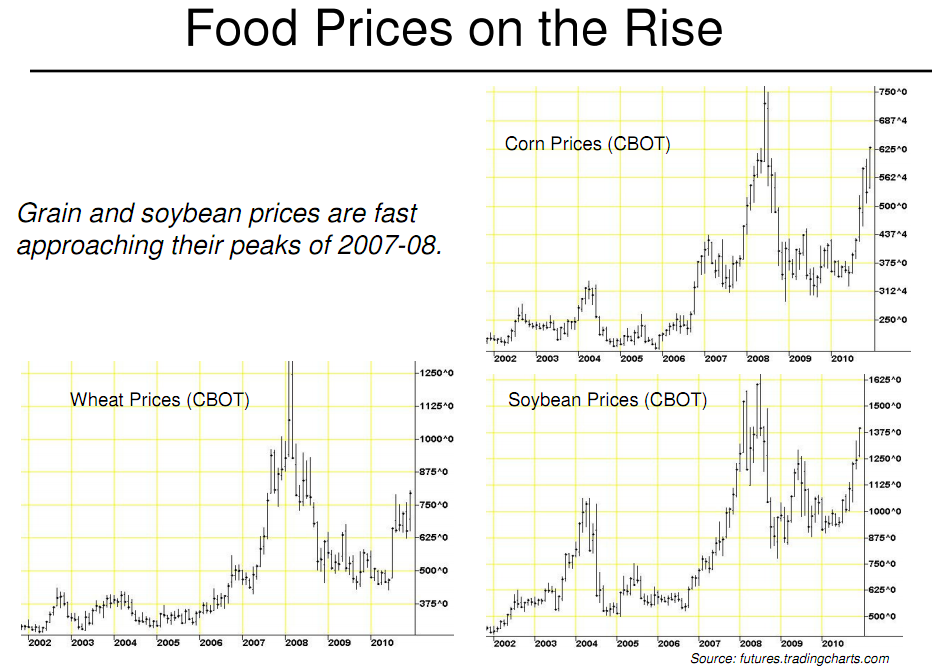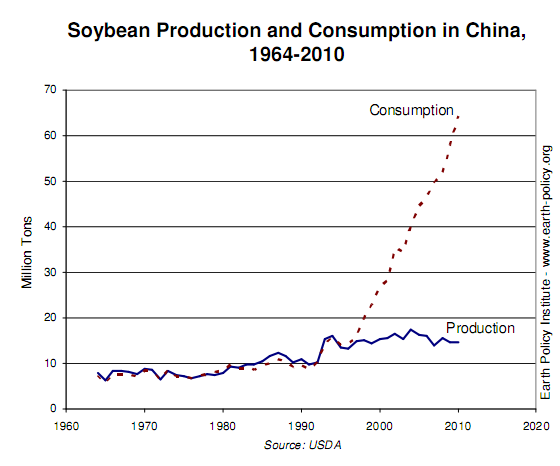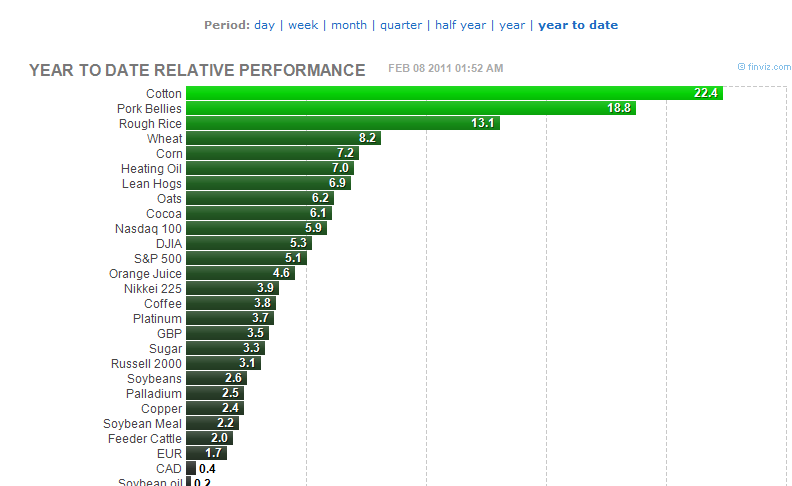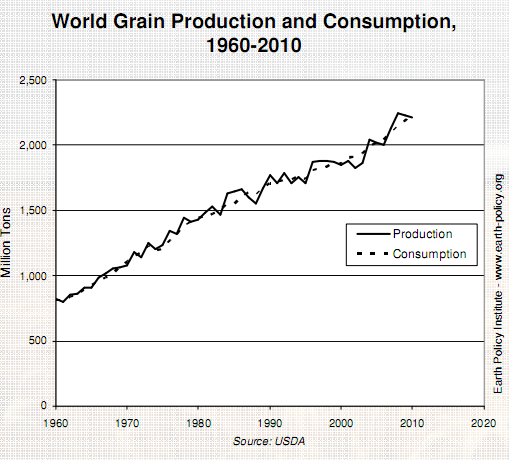The Food Bubble – the financial cost of feeding the world. Feeding 219,000 more people every night. Wheat prices up 8 percent for the year.
- 5 Comment
The word bubble has taken on an entirely new meaning thanks to the global housing bubble. Yet we have experienced bubbles in other areas outside of real estate. During the 1990s the nation experienced a technology bubble. That was followed shortly by a housing bubble. Both of these have burst. Yet we still have other active bubbles like the higher education bubble that sit ominously by with fumes pumping out like a volcano ready to explode. At the core of all these bubbles is the true catalyst which is access to debt. We have reached a peak debt scenario and many are realizing that the trillions of dollars owed by various entities including our government will never be repaid fully. I think many people get this. The Federal Reserve certainly understands this and would like to inflate our way out of this predicament. Yet one bubble that is rarely talked about in the media is the food bubble. Prices for various commodities have increased by large amounts over the last few years. Part of this has to do with growing economics such as China and India demanding grain-intensive products. Other parts of this growth have been built on misguided subsidies shifting corn production from food to fuel.
The incredible Russian heat wave of 2010 is one prime example of how sensitive global food markets have become. This heat wave produced average temperatures for the month of July that were 14 degrees above the average. During this time roughly 300 to 400 fires were starting on a daily basis. By the end of the heat wave total forest damage and restoration cost were pushing upwards of $300 billion. This heat wave caused crop failures that dropped Russian grain harvests by a stunning 40 percent. The repercussions from this in the region were that wheat prices saw a two month increase of 60 percent:
Source:Â Lester R. Brown
One can argue that the above looks like a bubble. We all recognize the pattern. Yet food is an absolute necessity. Just look at Maslow’s hierarchy of needs and we realize that this is a basic tenet of life. Unlike the technology bubble or the housing bubble much of the rise in food costs are coming from actual global demand, subsidies, and global currency devaluation. In other words, parts of the rise in food costs are based on bubble like dynamics but the wide demand from growing economies is also a large push. Just look at the below chart for China:
When we look at charts like this we realize that we are reaching a critical tipping point in certain markets. As the report by Lester Brown highlights a similar crop failure like that of Russia happening in the U.S.:
“Would likely result in unprecedented food price inflation and food riots in scores of countries, toppling weaker governments.â€
Here in the U.S. food inflation is being hidden by product packaging manipulation so we don’t hear much of the public reacting to this. But around the world this is an enormous deal and the repercussions are being felt by the people in a very real way. These psychological and branding smoke and mirrors has largely kept rising food costs out of the media. In fact, one month into the year and we can already see commodity prices still going upward:
Wheat is up 8.2 percent. Corn is up 7.2 percent. In an economy that heavily relies on meats and livestock that digests loads of feed, the cost works its way through the food chain and ultimately hits the consumer’s wallet. The American public already fragile with half of the working population making $25,000 a year on average or less is unable to support higher costs on most any item.  Manufactures figure that repacking food with less quantity for the same price will keep things under the radar. This seems to have worked domestically but globally the problems are piercing through the system. Take a look at this incredible growth:
We have to produce to meet the needs of the growing global population but also figure out ways to sustain this system. In China millions and millions of people are moving from the countryside into urban cities. As these nations become wealthier their consumption of meat and grain products rises astronomically. The livestock is grain-intensive and the volatility in commodities is likely to stay with us. Crop yields are also falling so farmers are struggling to keep their fields producing at maximum levels. There is only so much you can squeeze out of Mother Nature.
The biofuel rage is also shifting food to fuel. This creates competition within these two markets and will push up food prices higher. After all, it isn’t like the amount of cars in the world is shrinking:
Source:Â GlobalTrees
The food bubble is real and this is one bubble you cannot walk away from like an underwater mortgage. Thomas Malthus stated that:
“The power of population is indefinitely greater than the power in the earth to produce subsistence for man.”
The question is whether the world’s farmers can produce enough to keep up with the booming population of the world? The rising cost is showing us that tough times may be ahead unless something dramatic emerges.
If you enjoyed this post click here to subscribe to a complete feed and stay up to date with today’s challenging market!5 Comments on this post
Trackbacks
-
Robert said:
This is why efforts by Bill Gates to wipe out disease as a single goal, is misguided, and only makes the problem worse. Unless birth control is also part of his plan, it will only make people die of hunger, instead of disease.
Even if every govt. got together to feed everyone, so that no one died of hunger, once those people become ages 15,16,17, they will begin having children of their own, doubling the problem.February 8th, 2011 at 10:15 am -
kennyg said:
Wake up to begin to appreciate the abundance that we now have and stop taking your present blessings for granted………these will soon become the good ole days…… this you can be sure of.
February 8th, 2011 at 4:25 pm -
CPL said:
It’s called peak humanity
February 8th, 2011 at 8:50 pm -
Mike said:
There is enough land to produce enough food for the entire world a million times over. In a free market it is just about demand and supply. I have 3 pigs. They can produce hundreds of baby pigs. Two pigs produce more than enough meat for my family each year. I can do that in a very small area. The problem is always the government stealing the wealth from the workers. The answer is free markets with less government control.
February 11th, 2011 at 9:33 am -
beth said:
This is riveting article. People are simply just sliding by. Most get too lazy to even plant a small sustainable food garden, on land they have that is going to waste. What they have is big screen tv, luxury cars, massive homes with more space than they can ever live in, in a lifetime. Yet no self sufficiency. Of course there will be a food bubble and the world as we now know it will never be the same. People will be breaking into cars to steal someone else’s grocery. You are on the pulse, thank you for this article. He who exposes him/her self to knowledge is a smart man. He who exposes him/herself to knowledge and applies it will be the survivor & leader of the global economy. Blessings
February 13th, 2011 at 7:56 am






 If you enjoyed this post click here to subscribe to a complete feed and stay up to date with today’s challenging market!
If you enjoyed this post click here to subscribe to a complete feed and stay up to date with today’s challenging market!